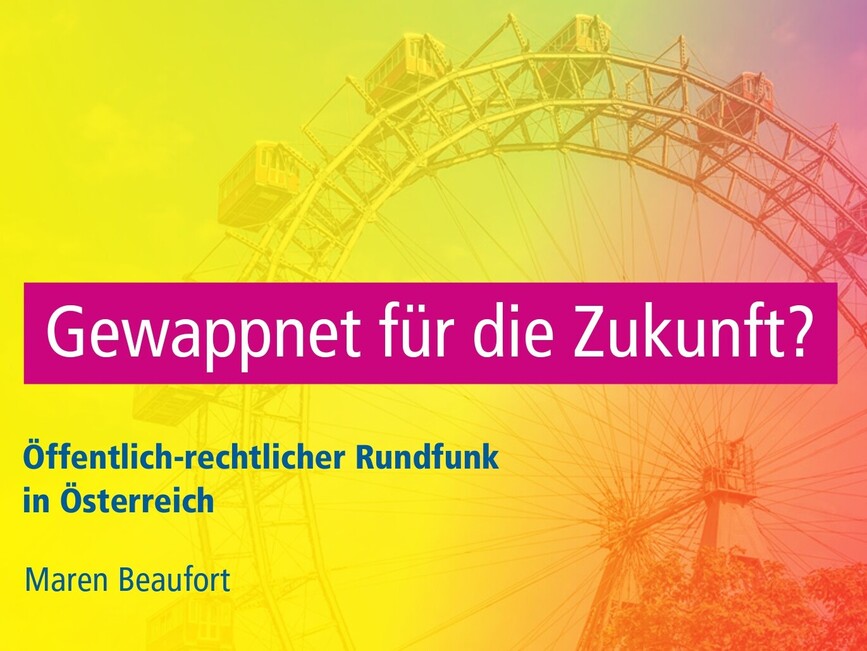The legal framework within which Austrian public broadcasting operates has strengths and weaknesses. Among its greatest strengths are the autonomy of journalists and programme makers, the freedom of journalistic practice – and the opportunity it provides to implement a multidimensional understanding of diversity.
In a digitized communications environment, a program that "must be oriented to the diversity of interests of all [...]" (as the ORF ACT states) can only be provided by using all distribution channels without content or time restrictions. Even more: in view of the postlinear logic of use, programming must be developed primarily with digital distribution channels in mind, be it the broadcaster's own media library or third-party platforms such as YouTube or Wikipedia – and not vice versa (Dobusch, 2021). The ongoing changes in the media landscape must be met strategically by public broadcasting to the extent that this requires a new type of thinking in platformized communication spaces that transcend national borders and are no longer comparable with the previous (top-down) communication structures.
Diversity in PSB law also means: diversity of regions and population groups, equality of women and men, inclusion of people with disabilities. Regionally, the ORF is in the best possible position and work on accessibility of all AV media content for hearing and visual impaired people is ongoing (recently on a more appropriate legal basis), but the "50:50 Challenge" adopted by Director General Wrabetz in 2020 from the BBC, which encourages programme makers to voluntarily evaluate the share of women and men in their programmes and strive for a more balanced representation, should be continued – and expanded. The BBC, with its recent target of 50% women, 20% ethnic diversity, and 12% people with disabilities, can again serve as a model (Binder, 2021). This applies to social diversity in programming as well as in newsrooms and management.
However, the most decisive dimension of diversity for the future of public broadcasting, which is not (yet?) enshrined in law, would take the different notions of democratic life as the primary programming guideline. Otherwise, social cohesion can no longer be ensured and social division cannot be combated. To enable people to participate in society, it is necessary, on the one hand, to activate existing readiness to participate in social matters, and, on the other, to create forums for networking and opportunities for interaction and exchange. This requires some kind of journalism that goes beyond the "objectivity ideal" and enables participation through contextualization, engagement and emotional appeal, and involves non-profit civil society organizations and citizens in the programming and production of media content as much as possible (at the expense of politicians and public officials). This may also help raise awareness for disinformation.
The greatest weakness of the current legal regulations concerns the composition of the boards and the appointment of directors. They actually invite influence on appointment and dismissal procedures for leadership and, in further consequence, editorial positions. According to the criteria of the "Media Pluralism Monitor", the independence of ORF's management and financing is at great risk (Seethaler & Beaufort, 2022). Seethaler (2021) therefore proposes three measures to counteract the anachronistic "politics-in-broadcasting" system:
- Reorganization of the Stiftungsrat, the highest body of management, with priority given to experts who are subject to professional ethical standards in their respective fields of activity, and/or an appropriate number of some kind of "broadcasting jurors" (Rundfunkschöffen), i.e., members selected by lot (Dobusch, 2021), and involvement of large civil society organizations in the appointment procedure with the obligation to disclose the internal decision-making processes.
- Public posting of management positions with well-argued, comprehensible qualification criteria, public hearings (livestream) and secret voting.
- Expansion of governance structures, in particular implementation of co-determination mechanisms in appointment procedures of editorial management positions, and participation in a yet-to-be-created cross-sectoral media council with responsibility and sanctioning powers.
References:
Binder, S. (2021). Excel-Tabellen für mehr Gleichberechtigung, horizont.at, 11 November 2021.
Dobusch, L. (2021). Von interaktiv bis staatsfern: Leonhard Dobuschs zehn Attribute eines idealen ORF, derstandard.at, 10 August 2021.
Seethaler, J. (2021). Fachleute statt Politiker und mehr Investigativjournalismus, derstandard.at, 14 September 2021.
Seethaler, J., & Beaufort, M. (2022). Monitoring media pluralism in the digital era: Application of the Media Pluralism Monitor In the European Union, Albania, Montenegro, the Republic of North Macedonia, Serbia and Turkey in the year 2021. Country report: Austria. Florence: Centre for Media Pluralism and Media Freedom (CMPF).
Beaufort, M. (2020). Medien in der Demokratie – Demokratie in den Medien: Ein demokratietheoretisch fundierter Ansatz zur Erforschung der demokratischen Qualität von Medienrepertoires unterschiedlicher Nutzungsklassen, dargelegt am Beispiel einer zeitvergleichenden Analyse des politischen Informationsangebots in den österreichischen Medien [Media in democracy – Democracy in the media: A democratic-theoretical approach to the quality of media repertoires of different user types. The case of Austria]. Universität Hamburg. ediss.sub.hamburg.
Beaufort, M., & Seethaler, J. (2018). Von neuen Formen der Kommunikation zu neuen Formen der Partizipation – oder umgekehrt? [From new forms of communication to new forms of participation – or vice versa?]. In K. Mitschka & K. Unterberger (Eds.), Public Open Space: Zur Zukunft öffentlich-rechtlicher Medien (pp. 133-142). Wien: facultas.
Beaufort, M. (2017). Bildung als demokratischer Auftrag [The educational mandate as a democratic mandate]. In ORF (Ed.), Der Auftrag: Bildung im digitalen Zeitalter. Public Value Jahresstudie 2016/17 (pp. 63-80). Wien: ORF. Retrieved from
